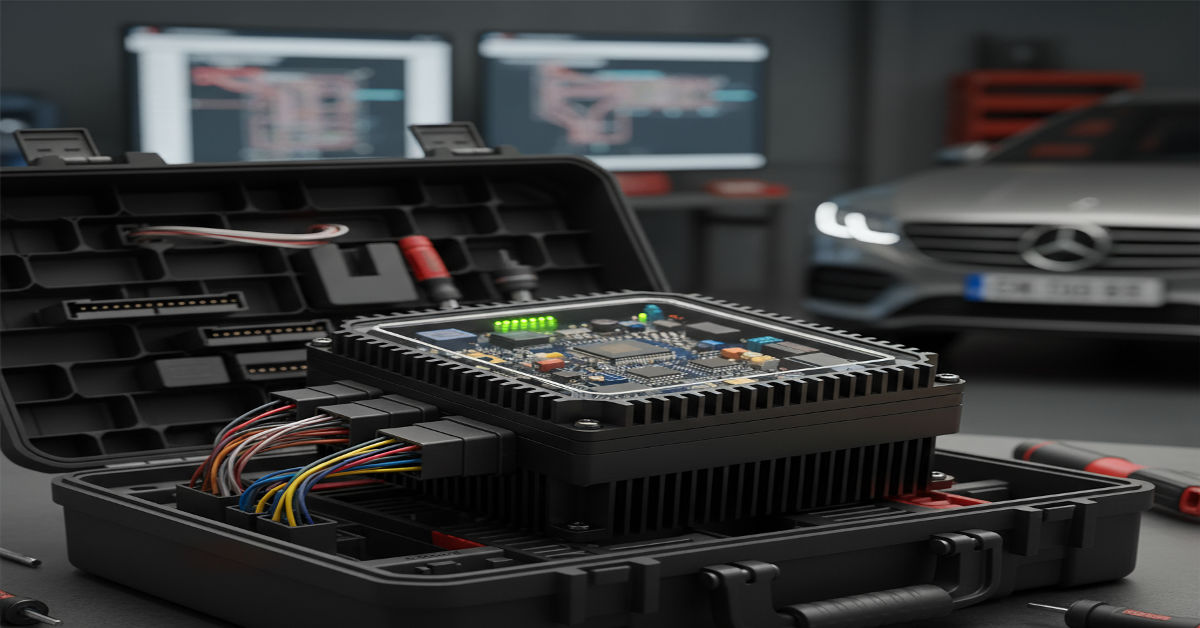Every modern vehicle depends on a complex electronic network that allows various systems to communicate seamlessly. At the center of this network lies the powertrain interface module, often called the PIM. It plays a silent yet crucial role by managing data between the engine control module (ECM) and the body control module (BCM). These two systems must constantly exchange accurate information for the vehicle to function correctly.
The PIM serves as a translator between these control units. It ensures that when the driver turns the key, the message to start the engine is properly authenticated and passed through to the ECM. Beyond communication, the PIM also acts as a safeguard. It helps in theft prevention and immobilization ensuring that only authorized access can start the vehicle. In many cars, especially earlier Holden models, it formed the backbone of the security protocol verifying every ignition request before allowing the engine to fire.
The Core Communication Bridge Between Modules
The powertrain interface module is essentially a communication bridge. Its role is to synchronize data flow between modules that may speak different electrical or software languages. Without this bridge, essential systems like ignition timing, fuel injection, and temperature monitoring could lose coordination.
When signals travel from the BCM to the ECM, the PIM validates their accuracy and structure. This filtering prevents data corruption or transmission errors. The result is smooth communication, stable operation, and reliable performance. To understand how deeply this synchronization impacts vehicle behavior, consider how even a slight delay between these systems can cause inaccurate readings, misfires, or total failure to start.
| Module | Function Description | Type of Data Exchanged | Dependency Level |
| Engine Control Module (ECM) | Manages air-fuel ratio, timing, emissions | Performance and sensor data | High dependency on PIM signals |
| Body Control Module (BCM) | Controls lighting, locks, wipers, and indicators | Command and status signals | Relies on PIM for verification |
| Powertrain Interface Module (PIM) | Acts as data gateway and security verifier | Real-time encrypted data flow | Central coordination node |
The flow between these systems is continuous and vital. Each message the PIM relays influences how smoothly the car runs and how accurately the dashboard responds to changes.
How the PIM Enhances Engine and Body Coordination
In vehicles equipped with a PIM, every action the driver takes involves a chain of communication. Turning on headlights, pressing the accelerator or starting the ignition—all these commands pass through the PIM. It ensures that each signal from the BCM reaches the ECM correctly.
This seamless link allows the engine and the body systems to operate harmoniously. For instance, when you switch on the ignition, the BCM sends an authorization signal that the PIM verifies before allowing the ECM to deliver spark and fuel to the engine. This coordination prevents unauthorized starts and ensures system reliability even under demanding conditions.
The PIM does more than relay signals. It interprets them based on voltage levels, signal strength, and timing. This ensures the messages remain stable even during electrical fluctuations, which are common in automotive environments.
Internal Design and Key Components
A typical powertrain interface module contains a microcontroller, memory chips, voltage regulators, and transceivers. Each part has a specific function designed to handle data integrity and safety. The microcontroller interprets signals, while EEPROM memory stores system configurations and error codes.
Voltage regulators protect against spikes that could damage the internal circuitry. Transceivers handle the actual data exchange between the modules through the CAN bus or other communication networks. The structure of the PIM is compact but powerful enough to process hundreds of signals per second without lag.
| Component | Purpose | Function Within System | Typical Failure Effect |
| Microcontroller | Controls all operations | Interprets input/output data | Data corruption or loss of signal |
| EEPROM | Stores error logs and configurations | Retains data during power-off | Inconsistent settings or no start |
| Voltage Regulator | Stabilizes incoming power | Prevents over-voltage damage | Circuit burnout or erratic performance |
| Transceiver | Enables communication between ECM and BCM | Converts and transfers data | No communication or signal loss |
Each of these parts must work in harmony. Even a minor fault in one element can disrupt the communication chain, leading to issues like a non-starting vehicle or inactive gauges.
The Role of PIM in Vehicle Security Systems
Apart from communication, the PIM plays a critical part in vehicle security. It verifies whether the key or transponder used to start the car matches the programmed codes within the system. If a mismatch is detected, the PIM blocks communication with the ECM, disabling the ignition sequence.
This layer of protection helps deter theft by ensuring that only authorized signals can activate the powertrain. The system is designed to respond instantly to discrepancies, preventing tampering or forced entry from enabling engine start-up.
The module’s authentication process is not limited to ignition. It also controls access to features like remote start and central locking, integrating vehicle safety with user convenience.
Common Powertrain Interface Module Faults
Like all electronic modules, the PIM can fail over time due to heat, moisture, or voltage irregularities. Some drivers experience a total no-start situation, while others might notice flickering dashboard lights or gauges that stop responding.
A common issue is communication loss, where diagnostic tools cannot connect to the vehicle’s system. This usually indicates a complete breakdown in the PIM’s internal logic or damaged connectors. In older models, corrosion within the harness can also interrupt power supply, leading to erratic performance.
Understanding Failure Symptoms and Their Causes
Identifying PIM failure requires close observation of certain warning signs. Drivers might experience intermittent cranking, an unresponsive fuel gauge, or the starter relay clicking repeatedly without the engine turning over. These issues can stem from circuit damage or software corruption within the module.
Technicians often report that when the PIM fails, scan tools cannot communicate with the system. This communication loss makes diagnosis challenging, often leading to unnecessary part replacements if not properly identified.
| Symptom | Likely Cause | Diagnostic Clue | Solution |
| Vehicle not starting | Signal failure from PIM to ECM | No scan tool communication | Replace or reprogram module |
| Fuel gauge not working | Broken data link with BCM | Dead gauge display | Check wiring harness and terminals |
| Starter relay clicking | Low voltage or corrupted logic | Intermittent starting attempt | Test voltage and reset module |
| Scan tool not connecting | Faulty internal circuit | Error during diagnostics | Reprogram or replace unit |
This table demonstrates how multiple vehicle systems depend on a healthy PIM for smooth and consistent operation.
Diagnostic and Troubleshooting Techniques
Proper diagnosis of the powertrain interface module begins with basic checks of voltage and ground connections. Once power integrity is confirmed, advanced diagnostic tools are used to verify communication between modules. If the scan tool cannot read data, the issue is often within the PIM or its connectors.
Technicians use oscilloscopes to analyze signal integrity and timing across communication lines. Any irregular pattern can indicate an internal fault. A module bench test, where the PIM is isolated and tested with simulated signals, is another effective way to confirm malfunction before replacement.
Replacement and Programming Essentials
Replacing the PIM is a delicate process that requires technical expertise. The new module must be programmed with the vehicle’s identification number and immobilizer data. This process ensures the car recognizes the new PIM as part of its original system.
Failure to program correctly will result in a no-start condition even after installation. Therefore, specialized software and tools are essential. Once installed, technicians verify communication with other modules and confirm that all fault codes are cleared.
Integration with Modern Automotive Networks
In modern cars, the PIM’s role has expanded far beyond basic communication. It now acts as a part of the larger vehicle network that connects systems like the transmission, braking, and infotainment units. These advanced integrations demand faster processors and higher data transfer rates.
Newer vehicles often feature PIMs capable of handling over-the-air updates and remote diagnostics. This allows for better maintenance efficiency and system adaptability without physical intervention.
Preventive Maintenance and Longevity Practices
Preventing powertrain interface module failure is easier than repairing one. Regular maintenance checks should include cleaning electrical connectors, verifying stable voltage, and inspecting for signs of corrosion. Battery health plays a major role since unstable power can quickly damage sensitive circuits.
Moisture is another common cause of PIM failure. Applying dielectric grease to connectors and ensuring the housing is properly sealed can extend its lifespan. Some technicians recommend regular software updates to keep the module compatible with evolving vehicle systems.
| Maintenance Step | Frequency | Purpose | Benefit |
| Inspect connectors | Every six months | Avoid corrosion and power loss | Reliable communication |
| Check battery voltage | Quarterly | Maintain stable supply | Prevents electrical surges |
| Software update | As released | Keeps firmware current | Better compatibility |
| Apply dielectric grease | After engine wash | Protects against moisture | Extends lifespan |
These actions, though simple, make a significant difference in maintaining consistent performance over years of operation.
Future Innovations in Powertrain Interface Modules
The future of PIM technology lies in artificial intelligence and self-diagnostic capabilities. Upcoming modules will be able to monitor their own communication efficiency and correct minor faults automatically before they escalate.
As electric and hybrid vehicles become mainstream, the PIM will manage even more complex data networks. It will need to balance communication between battery management systems, electric motors, and regenerative braking modules. With continuous innovation, the PIM is evolving into a smart data center that connects every electronic aspect of a vehicle.
Final Thoughts on Its Importance
The powertrain interface module may not be visible to drivers, but it is among the most crucial components in a modern vehicle. It ensures that different systems work in perfect harmony and that every signal travels accurately and securely. Without it, even basic functions like starting the car or monitoring engine temperature would be unreliable.
As automotive technology advances, understanding the PIM’s function becomes vital for both drivers and technicians. Its evolution mirrors the broader shift toward smarter, interconnected vehicles. With proper maintenance and timely updates, it continues to be the quiet force keeping every journey safe and smooth.
FAQs
1. What does the powertrain interface module do in a car?
It acts as a bridge that allows communication between the engine control module and body control module, ensuring all signals are correctly transmitted for smooth operation.
2. What are common signs of a faulty PIM?
Common symptoms include the vehicle failing to start, non-functional fuel gauges, or diagnostic tools failing to connect to the system.
3. Can I replace a powertrain interface module myself?
It is not recommended. Replacing a PIM requires professional programming to sync with the vehicle’s security and control systems.
4. How can I prevent PIM failure?
Regularly check for corrosion, ensure battery voltage remains stable, and keep electrical connectors sealed and clean.
5. What future advancements are expected in PIM technology?
Future models will include AI-based self-healing circuits and cloud connectivity, allowing for real-time diagnostics and adaptive communication.







